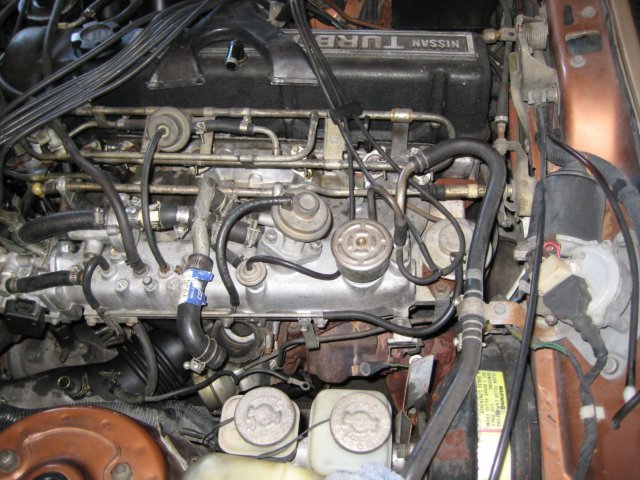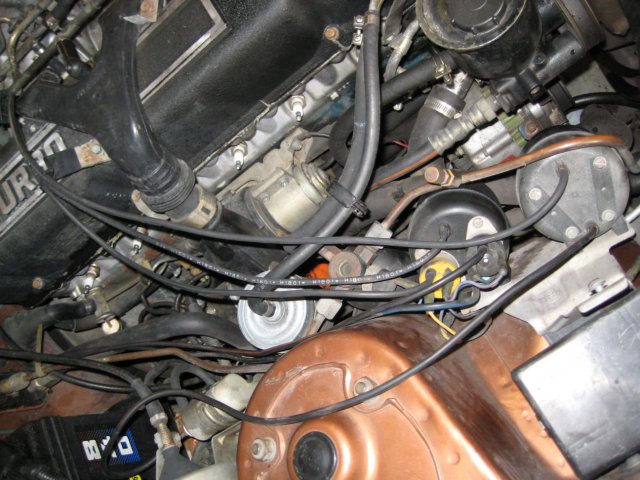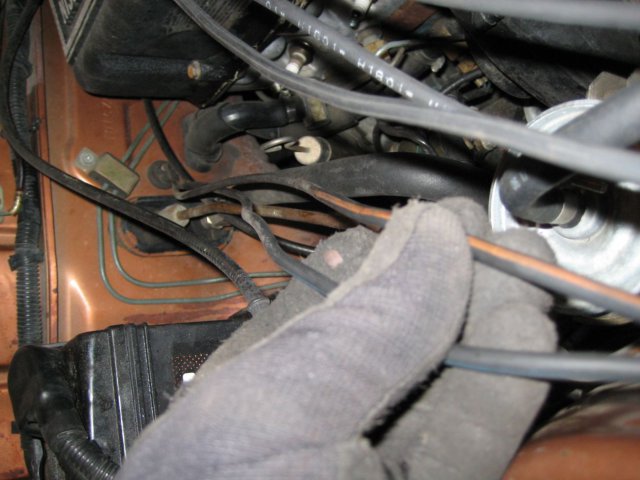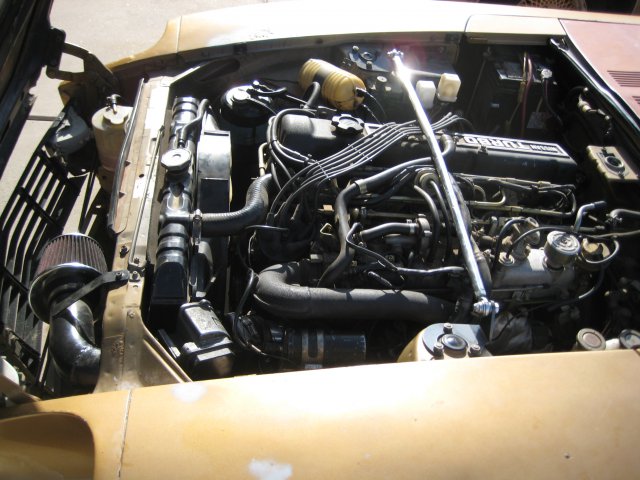-
Posts
672 -
Joined
-
Last visited
-
Days Won
8
Content Type
Profiles
Forums
Blogs
Events
Gallery
Downloads
Store
Everything posted by cgsheen
-

New bushings now arms wont fit?
cgsheen replied to J240ZTurbo's topic in S30 Series - 240z, 260z, 280z
Just looked at the pic again... Wow, ours were tight, but didn't "overlap" THAT much! My Son and I found success on our Z's by pressing in the inner bushings first - pushing them in real good - getting them seated tight as possible in the control arm. Then inserting the outer bushing and inner cylinder (in either order, whichever worked better - import part seemed to be getting the inner bushings in first and tight...) We did his Urethane bushings a couple of weeks ago. One side required a little "shoehorn" - we used a piece of sheetmetal. The other side went right up - snug, but we did it by hand... -
Spindle bushings = same as front control arm... Burn out the rubber, hacksaw the sleeve that's left (if you can't press them out).
-
The center consoles are made of ABS plastic. We plumbers have used ABS pipe and fittings for years. The ABS Cement ("glue") we use is actually ABS plastic resin in a solvent. (That means it actually deposits ABS plastic on/between the parts you use it on...) Works really well on many of the plastic parts in Z-Cars... You can get a small can of it at any hardware store, Home Depot, Lowe's. I'd use it in place of the JB Weld suggested above - either as mentioned or with another piece of ABS plastic glued and clamped over the crack if possible (plastic piece from an unused/extra panel - just about all the black plastic in a Z is ABS). It's pretty easy to cut and fit ABS. No one will ever see it if it's on the underside of the console and it will never break there again if you do it properly...
-
Lots! Search "spindle"... Really helps if you have penetrating oil and an impact wrench!
-
Hmmmm... When I did my swap, I used the coil wiring (and coil / ignitor) from the 280ZXT. It's a little different arrangement than the 280 coil wiring. It goes from the ECU up the driver fender to the coil location. Then I just ran the Tach signal wire from the ECU location to my existing in-line resistor (which is under the glove box on my 260) and tied it into the wiring from the original Tach feed... Sounds to me like you're running the Tach signal through TWO resistors. Correct me if I'm wrong here: The original coil wiring on the 280Z comes from the transistor ignition box under the dash near the glove box? It goes up the wire bundle along the passenger side, across the radiator, and down the driver fender to the coil? The tach signal wire follows the same path from the coil BACK to the wiring junction under the glove box, thru the resistor, and then to the tach gauge? To me it sounds valid to run the Tach signal from the coil to the original tach signal wire near the AFM, but you shouldn't have the 280ZXT Tach resistor in line... You already have the correct resistor for your Tach in the signal wire - unless you've removed it.
-
You're correct about the rheostat - it's the "dimmer". In electrical terms, it's a "variable resistor" that can control the current going through it. The rheostat doesn't have anything to do with the running lights though (well... it shouldn't...). It's fed by the same source, but it's output only goes to dash lighting, and it's only purpose is to control the brightness of those bulbs. Jumper: A switch is just a way to "break" a wire. Hold the wire apart, whatever it feeds is "switched off". Touch the ends of the wire together, whatever it feeds is "switched on". The switch on the light stalk has the GW and GL wires soldered to it. Take another piece of wire stripped at both ends. Touch one end of your little wire to the GW solder pad and the other end to the GL solder pad at the switch. That creates a "jumper" between the two wires. You've just bypassed the switch in the light stalk and powered the running lights directly by using your little jumper wire. The only thing this checks is the running light switch inside the stalk. If the running lights work properly when jumped, the internal switch is bad. If they're still funky, you problem lies elsewhere - trace the power down the wire. Check the connectors near the steering column. The bundled and wrapped sections of wiring are least likely to have a fault, unless you can see a cut, scrape, gash, pinch - obvious damage - to the wire bundle. Most likely to have fault are the connectors - especially under the dash at either edge of the windshield (most likely spots to leak water) - AND the wiring, connectors, at the front of the car. Pull those big connectors under the glove box apart and check them for corrosion. EACH running light has a socket, bulb, wiring (power AND ground), and connector to the harness that needs to be thoroughly checked and cleaned. You may need to remove or disconnect ALL of the running lights and then plug them back in one at a time to find the fault...
-
At the 2010 MSA Z-Meet (last April) in California, my son's '76 280 (stock L28ET swap) dyno'd at 153 RWHP and 180 something Ft/Lbs torque. A kid with a stock 280Z had his dyno at <120 RWHP... But, think about it - It's basically the SAME engine - only with a turbo.
-
Well, you were right - it's the Green/white wire on the combo switch attached to the lights/wiper/washer stalk on the right side of the steering column... "Supply" voltage comes in on the Green/blue wire - should be +12v all the time (lights will turn on without the ignition key being in or turned). You can check the switch by jumping the Green/blue and Green/white - see if the running lights come on. (Although the same Green/white sends power to the dash lights also - through the rheostat... If the lights in the gauges are working, the switch is working...) Looks like Nissan ran GW for power to the rear markers and tail lights, and GL for power to the fronts... I'd check the wiring and connectors between the switch and the rheostat or there-abouts if NONE of the running lights work. Then you'd have to chase wiring through the car. Connectors and Grounds are most likely. One of the biggest problems in these Z's are electrical connectors - check and CLEAN them all. Including the lights and sockets...
-
#3 - That big hose shouldn't be there... Only two are needed, one inlet to the heater core, one outlet. Someone did something funky under the dash?? There's the aforementioned valve connected to one side of the core by a short piece of hose (and it's operated by the temperature control cable NOT a vacuum solenoid like I said above...). One of the water hoses connects to that valve, the other directly to the core. But still, there should only be 2 water lines under there...
-
Well, there's a few extra things on the turbo intake, but the basic parts and vacuum stuff is generally the same on all of them. The little valve on your last picture is for the A/C system. It increases the idle speed if the A/C is running. The missing line should go to your Idle Air Controller...
-
Here's a pic or two of an original '81 280ZXT with the J-pipe and wiring harness out of the way. Hope it helps some... All of this should be in the FSM.
-
That's the EFI relay for the L28ET. The Brown wire is +12v from the battery through a fusable link, Black is GND, and one Black/white is "signal" from the Ignition switch (+12v when in the "ON" and "Start" positions), the other Black/white is switched +12v to power the ECU, VCM, and CAS... With stock wiring, the ECU on the L28ET has complete control of the fuel pump... The ECU sends the "signal" voltage to the coil in the fuel pump relay, so it controls switching the relay on and off.
-
I only have the wiring diagrams from my '74 and my son's '76. They both show the stock wiring from the "thermal transmitter" as yellow, then yellow/white going from the sensor into the "engine room harness" then through the firewall to connector C-5 under the glove box. Connector C-5 is on the lower row, 2nd from the left and is green in color. The yellow/white wire is at one end (of the 5 pairs of smaller wires) and has a yellow/black wire directly opposite (the small wires at the other end of the connector are green/white and white/red). The engine room harness runs along the frame on the passenger side, goes across the beam in front of the radiator, and over to the coil location if I remember my son's '76 280 correctly. There's a 4-pin connector (round, I think) near the coil that gets abandoned when you do the swap. I think the yellow/white from the sensor starts there and runs to C-5, then into the dash harness and straight to the temperature guage. I ran my turbo harness much like the donor it came out of. That put "connector 3" and the yellow wire from the temp sensor near the battery. I ran the yellow wire through the firewall (where all the other wires come through) and connected it to the yellow/white coming out of C-5 running to the guage...
-
#1 - That's what I did on my '74... I used the existing wiring and installed my "one-wire" oil pressure sender on the L28ET. It works. We did the same thing on my son's '76... #2 - Not plug-n-play but not difficult. The Turbo engine harness has a yellow wire and a white wire that go up to the front of the engine and attach to the coolant temperature sender (yellow) and the thermotime switch (white). Unless you're using the injector blower and it's fan timer box from the 280zxt, you ignore the thermotime switch and it's white wire. The yellow wire hooks up to your temperature guage. On the turbo engine harness, the yellow wire terminates on "connector 3" - which is white plastic 6-pin connector (5 pins are used - other wires to the connector are Black/white, Blue/red, Green, and White) #3 - Nope, something is not quite right there. Shouldn't be any water in the small hose, I believe that should be vacuum and connected to the vacuum bottle or the vacuum solenoids just forward of the battery. Yep... Just looked at the Factory Service Manual. There's a vacuum line connected to the "Vacuum Cock" (which is a valve in the heater core hose beside the core itself. The valve is operated by a vacuum source which runs through the heating & cooling selectors and then to the "Magnet Valves" (solenoid valves) near the vacuum bottle attached to the fender well...). I'd bet actual money that your "Vacuum Cock" is broken / has a bad diaphram, and is leaking water where it shouldn't... Don't hook that tube up to vacuum! Not until you replace that valve near the heater core. (That may also mean water is throughout all the vacuum tubing & vacuum operated devices under the dash...) #4 - I'm pretty sure the relay in the '83 fender IS the Fuel Pump Relay... Your '75 has one of it's own. If you're using both it's redundant... When I did my swap, I used the EFI and Fuel Pump Relays from the 280ZXT and wired them into my existing harnesses, abandoning the original fuel pump relay (I didn't have an EFI relay to begin with). The fuel pump relay is controlled by the ECU on the turbo engine. For safety reasons, I'd leave it that way. Check your wiring and make sure you follow the 280ZXT wiring method for the fuel pump. The '83's also had a fuel pump modulator box that attached to the ECU harness. It varied the voltage to the fuel pump. Are you using that?
-

My 240z T31 moving to colorado?
cgsheen replied to chrismiller5157's topic in S30 Series - 240z, 260z, 280z
cough - toldyouso - cough... -

need help with 83 turbo 2.8 swap in a 260zx
cgsheen replied to dukeluv280zx's topic in Trouble Shooting / General Engine
Ouch... That's a shame... Unfortunately, you're going to have to know a bunch about BOTH Z's to sort all that out. Get the Factory Service Manuals for the '76 280Z (ya, 280Z - not 260...) AND the '83 280ZX (with Turbo supplement). Although, I'm not certain that's an actual '83 L28ET engine - if it is, MUCH has been changed. No sense even trying to start it in it's present condition - it won't go (and if it does, you don't want it to!). There's no AFM, the compressor on the turbo isn't connected to the intake manifold (that's NOT an '83 280ZXT intake), who knows what's up with the wiring... If you keep the 280ZX ECU, there's a bunch of stock parts you'll have to get. Otherwise, you'll have to switch to a stand-alone EFI / engine management system (like megasquirt) and install different parts. I don't see an easy way around this one. Hit the books & start learning! BTW, here's my son's '83 L28ET in his '76 280Z chassis. Bone stock L28ET swap (except the cone air filter). Looks almost exactly like the stock L28ET in my '74 260Z chassis... -

out of ideas! car wont start 81 280zx turbo
cgsheen replied to Daniel13brx7's topic in Trouble Shooting / General Engine
The L28's don't use EITHER of the temperature sensors up front in the thermostat housing for EFI. One goes to the coolant temperature gauge, the other is the "thermotime switch" which runs the Injector Fan at shutdown if the coolant is above a certain temp... The temperature sensor your engine DOES use is the Cylinder Head Temperature Sensor which is in the side of the head, passenger side, closer to the firewall than the radiator, and it should have an electrical connector the same as the connectors on the Injectors. No way in hell my turbo motor runs for more than several seconds with the fuel pump killed! (I know, I used to have a switch in the fuel pump power lead and could turn it on and off from the cockpit) As per usual, you should check and clean ALL of the electrical connectors on the EFI Harness (actually ECCS Harness...) and the troubleshooting guide / diagrams in the FSM for the '81 280ZXT are really good and fairly easy to follow in testing fuel and ECCS components. I had a complete, running '81 ZXT for a time as I was doing the L28ET swap into my '74 260... -

Need a very specific picture of an L-series valve cover
cgsheen replied to iBang's topic in Nissan L6 Forum
My oldest Son would dig one of those for the RB he's swapping into his M30! Then his engine would "match" mine AND his younger brothers... -

My 240z T31 moving to colorado?
cgsheen replied to chrismiller5157's topic in S30 Series - 240z, 260z, 280z
I don't know why you need a truck in snow country - unless you NEED a truck... Small, light vehicles work best in the snow and mass over the drive wheels helps - neither of which describe most pickups. Growing up in Idaho, most of the pickup owners would load the bed with sandbags during the winter to get some weight over the rear wheels. Otherwise, just get used to "drifting" as the back end slides every time you apply throttle. (We did a LOT of that growing up! We just didn't know it was "drifting". We called it driving on the snow and ice or on the dirt / gravel roads. Driving sideways was a way fo life...) I doubt you'd be driving as much or as far in Fort Collins as you do in Texas - it's not that big a place... When the weather is nice, there's NOTHING like driving a car that turns well on back-roads over the Continental Divide! You won't find anything in Texas like the Rockies... (No Z's back then but I helped my Dad ferry new '66 Mustangs from the Ford Dealership in Idaho Falls to Jackson Hole, Wyoming. What a drive.) Now I have to settle for taking my 260 up the winding 2-lane road from Apache Junction to the canyon lakes near the Superstition Mountains east of Phoenix. Not quite the same, but this Z sure can turn! -

'82 Turbo sputtering issues
cgsheen replied to Over30S130's topic in Trouble Shooting / General Engine
Go through all the EFI (should say ECCS) harness wiring and check/clean ALL the connectors (including the connectors to the ECU). (bad, dirty, oxodized, non-existant connections account for a LARGE portion of the problems with these early EFI systems) There are relatively simple tests listed in the FSM to check all the individual ECCS components: AFM, Air temp sensor, cylinder head temp sensor, O2 sensor & all the rest... -
Wow... My Son and I JUST pulled the spindles on his '76 280 a couple of days ago. He finally replaced all of his bushings. Took some time and patience, but we got his out without destroying the ends. It's good to have a compressor and an impact gun... and penetrating oil... and some old lug nuts... oh, and lots of luck!
-

Lost power to wheels while driving
cgsheen replied to XedLos's topic in S30 Series - 240z, 260z, 280z
Fuel pressure? It's so rythmic, sounds like fuel starvation... Did you double-check your spark plug wiring? Then, it's always a good idea to check all of your electrical connectors on the EFI harness. -

1978 280z poor acceleration and stutters.
cgsheen replied to KetchupNinja's topic in Trouble Shooting / General Engine
Poor electrical connections are also the bane of Z cars in general and EFI & ECCS Z cars in particular. Before you screw with the AFM or ECU, go through the wiring and check and clean ALL the connectors. Special attention on the AFM connector, ECU connector, CHT (cylinder head temperature) sensor connector, injector connectors, O2 sensor connector. Be sure to check / clean both sides of the connection. Run through the EFI component tests in the Factory Service Manual - they're not difficult and you can check every component associated with the EFI system AND it's wiring back to the ECU. -

1977 280z fuel injection problem
cgsheen replied to zsteelman's topic in Trouble Shooting / General Engine
How long has it been sitting? Both of the L28ET's I've swapped had "frozen" injectors - probably because they were taken out of service and sat unused. Couldn't get a click out of any of them. Had to "cycle" each injector dozens of times manually to get them opening... -

COMPLETE list of everything needed for L28ET S30 swap
cgsheen replied to RSready's topic in Nissan L6 Forum
My 260 frame didn't have a radiator, so I'm using the 280zxt radiator from my donor. Cools well, doesn't fit my frame very well and hangs down a little too far... The 280's have a "dip" in the frame just forward of the radiator that mine doesn't. My son is using his stock radiator - he's got a 76 280 that we L28ET swapped almost 4 years ago now. We're in Arizona - hot as Hell - both cars run A/C - and he hasn't had any problems with cooling. I don't know how much difference this is between the turbo radiator and the 280Z radiator...




